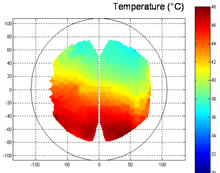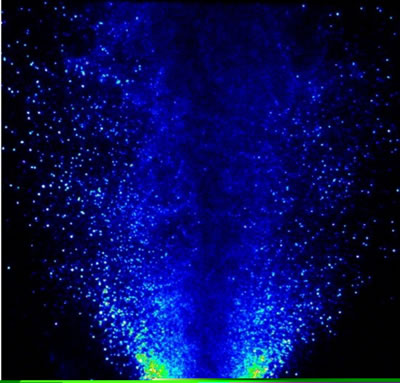And what if we could reduce the consumption of aeronautic engines by controlling the evaporation of micro-droplets of kerosene?
Number 43
![Sur ce banc on reproduit l'évaporation des gouttes de carburant dans les conditions des moteurs. Des techniques laser permettent d'en mesurer toute la dynamique. [Photo Antoine Gonin]](/sites/default/files/actualites/magazine/zoom_in_the_lab/43-evaporation-gouttes-visualisation-laser.jpg) This test bench simulates the evaporation of fuel droplets in engine conditions. Laser techniques are used to measure the dynamics of the whole process.[Photo Antoine Gonin] |
"In a conventional internal combustion engine, whether automobile or aeronautic, the fuel is injected as a mist of droplets into the combustion chamber where, by the effect of heat, these drops evaporate and the vapor created is mixed with air before igniting" explains Fréderic Grisch, researcher of the Measurement Physics department and Onera-side coordinator of the CNRS-Onera aerospace federating project "Experimental and analytic methods for multi-component mists". |
The evaporation of the drops is a key stage: if drops of combustible liquid remain in the chamber, they will not burn efficiently, or even not at all, with negative effects on consumption and the emission of pollutants.
Visualization of the liquid phase of a droplet mist using fluorescent imaging |
It is a complex phenomenon, occurring where several disciplines meet - aerothermics, fluid mechanics, chemistry, mass and heat transfer, etc. The micro-droplets of fuel that constitute the mist contain hundreds of different types of chemicals, evaporating at different speeds and different temperatures. To help industry to design better injection systems, we have to go further in our understanding of the phenomena involved. Hence the launching of this PFA (federating aerospace research project): “the objective is both to improve knowledge and also develop a computing model that may possibly be used in industry” explains Frédéric Grisch. |
Given the importance of the evaporation phase for combustion performance, it is clear that we have to analyze the droplet mist from all angles (size and speed of droplets, average temperature, temperature distribution within the drop, flow rate, etc.) in order to understand how the droplets behave when passing from the liquid to the gaseous state. Now, these drops have a size that varies between 1 to 100 microns, and they move very quickly in the turbulence generated by the hot air. In other words, it isn’t very easy to catch them mid-flight! |
 Temperature distribution in a droplet: measurement by LIF (Laser Induced Fluorescence). |
This is why the teams at the CNRS and Onera, who have excellent complementary skills in the various techniques of measurement and visualization, have been mobilized to “snap” both the liquid and gas phases. They use particle image velocimetry (PIV), laser granulometry ((Phase Doppler Anemometry – PDA) and laser induced fluorescence (LIF). |
|
| The project is organized around two pilot experiments. The first experiment – a calibration exercise, consists of studying the evaporation of a "train of drops" - a succession of droplets of identical size and speed, one after the other. First, a team specified and developed an injector, which everyone would be able to use for all their own measurement installations. “This first step gave us the opportunity to find our bearings, refine our measurement techniques, suitable for evaporation, test them and compare the first results with the simulation” explained the researcher. Then the teams set about a second experiment, closer to the conditions in an engine. Here the same measurements techniques were to be used but on a droplet mist injected into a flow of air with a known and controlled turbulence. | Digital simulation of the dynamics of the evaporation of a droplet in a jet of mono-dispersed droplets |
| For this work a fluorescence technique adapted for a mist had to be developed. Our energetics specialists have taken advantage of this to include it in the programs and models developed for the droplet train inside the Cedre code - the Onera multi-physics software platform used for the simulation of reactive flows. This team then simulated the evaporation in the conditions for this second experiment, and compared the results with those obtained by laser measurement. At its conclusion, the contributors to this project regard it as a real success, particularly for what it has yielded in a better understanding of the phenomenon of evaporation, and also the progress made in terms of simulation techniques. “It has been a real success in scientific terms. The project has resulted in 20 publications in the peer-reviewed journals, and 51 papers at congresses. And at the human level we have built up a real cooperative network. Everyone has contributed something and benefited from the work of the others” is the conclusion of Fabrice Lemoine (Lemta-Nancy), CNRS-side project coordinator.
Cécile Michaut, scientific reporter |
|





